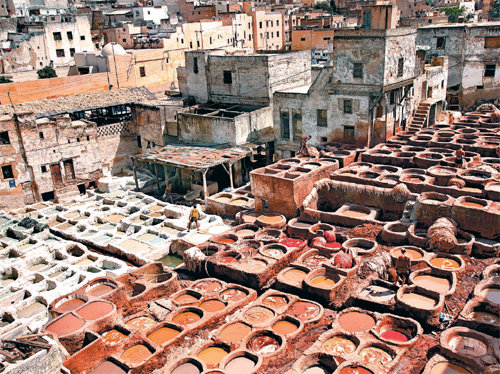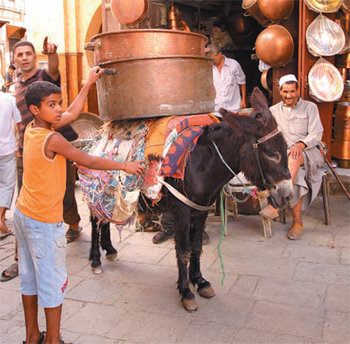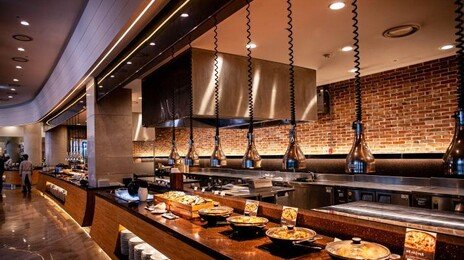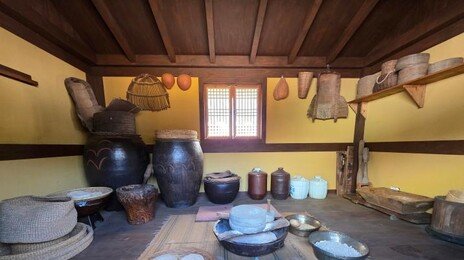공유하기
<3> Living with the Past. Fes, Morocco
- 동아닷컴
-
입력 2010년 8월 31일 00시 00분
글자크기 설정
Living with the Past in Heady Arabian City

《 I found it hard to breathe under the blazing sun. It was the kind of heat that felt as if things would dry up and crumble before they decay. The city of Fes in Morocco, North Africa, stood majestically under this scorching daylight after enduring for more than a thousand years. This ancient Arab city, 200 kilometers from the capital city of Rabat, didn't need any elaboration. Even if it weren't selected as a world heritage property by the United Nations Educational, Scientific and Cultural Organization, the city's monochromatic color, resembling the desert, was beautiful because it was simple. 》
Fes, Morocco = Jung Yanghwan, Staff Writer
"There comes a point when even nomads of the desert want the physical comfort of a sedentary life. When a strong dynasty has such a desire, the prosperity of a city begins to blossom."
Ibn Khaldun, Islamic philosopher of the 14th century
"You haven't arrived in Fes until you've hit your shoulders against a narrow alley trying to avoid a donkey," he said.
When the city thrived in the 11th century, an Islamic poet called the streets of Fes "the stream of flowing wine." Like weeds that sprouted by themselves, no street - there are about 9,600 of them - looks the same. Narrow streets widen out while seemingly straight streets bend. The maze of streets are like mutton intestines. Mounouar Boubker, a 32-year-old UNESCO official who accompanied me from Rabat, patted my shoulders.
"Don't be afraid that you might get lost. It's not too bad to wander around. It'll feel like arriving at the door of an old civilization," he said.
Just in time, an old man with a long beard pulled me into his Islamic-styled house. He had the grace to invite me in even if he didn't have much. The shy wife looked on as her husband pointed at his refrigerator shouting "LG, LG." The couple's smile, the warm hearts of the family - this was Fes.

The streets they shaped have a high historical value. A blue fountain, only a few steps from the old man's house, was there from the birth of the city. Under a grass-colored roof built in the 15th century lay the grave of king and mulla Idris, which was off limits to infidels. The world's oldest madrasah, an Islamic college, was attached to the Kairaouine mosque, which was built around 860. There are 143 mosques, seven madrasahs and 64 fountains in the city. Each corner of a winding street breathed out a culture that connects the past and the present.
"Breathing is a scientifically correct term to describe the traditional houses of Fes," said Mouhcine el Idrissi el Omari, culture officer of the local government. "The walls are built of mud bricks, lime and sand. These walls let out heat in the summer and hold in warmth in the winter. Residents call this breathing," he said.
At the high point of this smell is the Chouara Tannery, a Fes landmark that has existed for thousands of years. Workers jumped over pigment barrels under the burning sun. They added color to lamb and goat leather with sweating hands laden with tradition. The mysterious colors that spanned every shade from red to gray had all been part of nature, from poppies and saffron to pigeon droppings and cow urine. I noticed that the eucalyptus leaves that were handed to me at the entrance of the tannery were a kind of air freshener, but it was already too late. The strong odor had already enveloped me and taken my soul. With the magic of the sun, the maze and the smell.
"Is beauty dangerous?" "No, it's not beauty, but the way you possess it that's dangerous."
from the Star of Africa, a Korean novel by Jeong Mi Kyung
Beauty is hard to retain. The passage of time and idleness eat away at the edges. In this city of a thousand and two hundred years, the ups and downs of life coexist. Maintaining Fes is something of the present as well as the future.
This is why the sounds of hammering aren't strange in Fes. Every mosque that Mr. Boubker showed me had new mosaic tiles and wooden planks. The Moroccan government and UNESCO began the restoration of 50 major historical sites in Fes since the city became a world heritage property in 1981. The restoration has cost more than $600 million (KRW715 billion) so far.
The outcome wasn't a failure, but more needs to be done. Walls crack again and again even after repairs and patches. The relics are especially vulnerable during the winter rainy season. "Five people died when a building collapsed during heavy rains in December," Hamid said. Mr. el Omari was well aware of the problem.
"Fes is valuable because people live among their cultural assets. Traditional lifestyles are as important as the historical properties. But living in old houses can be dangerous. We need constant maintenance and repairs, but we don't have enough funds and experts," he said.

Many have left their hometowns because of the impoverished environment. Until the 1980s, Fes Albali (Old Fes) had a population of almost 150,000. That has gone down to about 100,000 and quite a number of houses have been abandoned with locks on them. Empty houses age faster.
A black market targeting these houses have prospered. Every piece of door and tile are a historical relic so many people go after them. The problem hasn't been reported publicly, but residents aren't surprised. "The black market also has artifacts from mosques and madrasahs," said one resident.
UNESCO is deeply concerned about this problem. "Education will determine the preservation of Fes," said Secretary-General Touriya Majdouline of the Morroccan National Commission for UNESCO.
"Preserving cultural assets requires a long-term view more than anything else. For Moroccans, Fes isn't just a tourist spot, but their spiritual capital. We have to sow the seeds of such pride in the residents and the next generation. We should build the foundation for them to preserve and prosper by themselves through cultural education," she said.
It was an appropriate response. But when will the seeds of change trickle down to the grassroots? The words of a master craftsman of a metal craft workshop that I chanced upon, was matter of fact but saddening.
"I have made bronze artifacts all my life. It's been our way of life since the father of my father. I don't know how to do anything else. But recently, I've been thinking of quitting this work. There are still many tourists, but hardly any of them look for handmade craft. I understand why they want to buy cheap merchandise made by the dozen in factories. Young people don't want to learn this line of work since it's hard to make a living. Government support? I wouldn't be worrying now if we had that," said 43-year-old Muhammad, who declined to give his last name.
Just before I left Fes, I ran into another donkey carrying a load on its back. It had probably walked these streets scores of times, but hesitated for some reason. The donkey's old master lashed his whip. The animal moved its feet against its will. Was that tears I saw? I kept on looking back but could only see its faltering tail. Who can tell the future of a tired donkey, but the sun above Fes began to set slowly.

Fes can be divided into three areas: Fes el Bali (Old Fes), which was formed in the 8th century, Fes el Jdid (New Fes), which was founded by the Merinide dynasty in the 13th century, and Ville Nouvelle, which was created during the French colonial days. Among the three districts, UNESCO-listed world heritage site Medina of Fes refers to Fes el Bali. Medina originally meant sacred place in Islamic culture, but is now used to mean downtown including mosques and markets.
-
- 좋아요
- 0개
-
- 슬퍼요
- 0개
-
- 화나요
- 0개







댓글 0